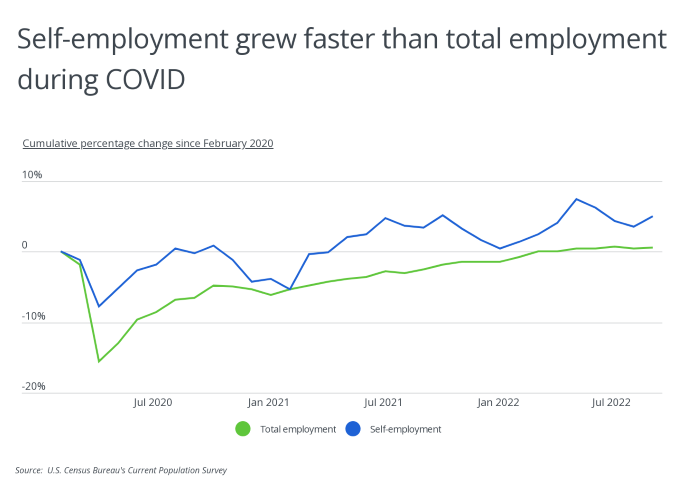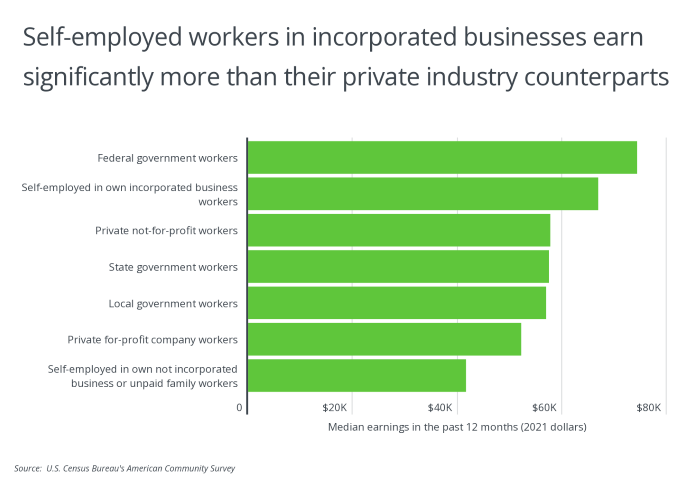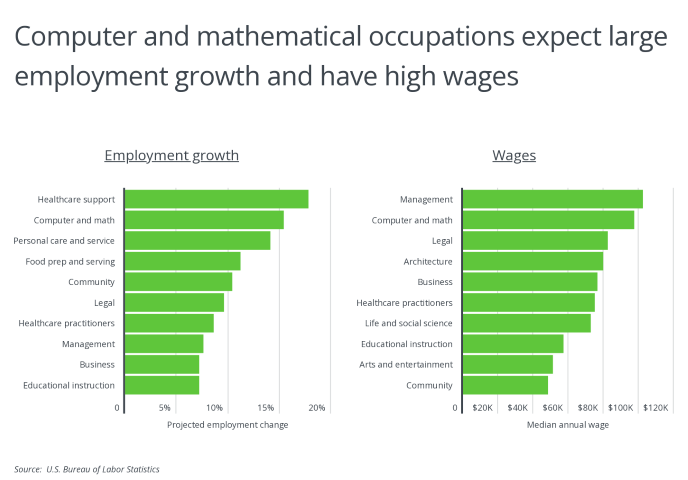Best Occupations for Being Self-Employed
 Photo Credit: Dragon Images / Shutterstock
Photo Credit: Dragon Images / Shutterstock
November 8th, 2022
While recent data indicates that tightness in the U.S. labor market may be easing, workers continue to have remarkably high levels of power and choice in the labor market.
The COVID-19 pandemic fundamentally reshaped many workers' relationships to their jobs. Lockdowns early in the pandemic sparked massive layoffs, and ongoing issues like concerns about health and safety or availability of child care made it difficult for many to return to work.
Desires for improved working conditions, better pay and benefits, and roles more aligned with peoples' lifestyles or professional interests eventually set off unprecedented mobility in the labor market. This is now commonly known as the Great Resignation.
Healthcare support offers the greatest projected job growth over the next decade at 17.8%, while management occupations have the highest median wages at $102,450
Today, labor force participation rates continue to trail pre-pandemic levels. Quitting remains historically high after reaching a record of three million per month late in 2021. The number of job openings in the U.S. has topped 10 million per month for more than a year. These figures suggest that workers feel they can be selective about what jobs and working conditions they will accept. Currently, they are more willing to take time off to wait for good jobs, or to move on from their current positions for better opportunities.
Under these circumstances, self-employment has proven to be an increasingly popular choice for many workers. Self-employment often offers more of the qualities that workers want, like more flexibility in schedule or location, and less of the ones they don't, like feelings of disrespect or lack of opportunity for advancement. As a result, the ranks of the self-employed have grown over the last two and a half years.

In the wake of early COVID-19 lockdowns in March and April 2020, self-employed workers lost jobs at just half the rate of all workers. While total employment did not recover to pre-pandemic levels until March 2022, self-employment briefly bounced back to pre-pandemic levels as soon as August 2020 and has remained above that threshold since May 2021. Today, total employment is just 0.6% greater than it was before COVID-19 hit, while self-employment is up by 5.0%.

Autonomy and flexibility have been significant drivers for self-employment, but it also has the potential to boost workers' earnings. The median earnings for workers who are self-employed in their own incorporated business over the last 12 months exceed earnings for every other category of workers, except federal government employees. Self-employed workers in incorporated businesses earn nearly 30% more than their private industry counterparts, with median earnings of $66,864 and $52,137, respectively.

Job outlooks and earning potential vary by industry, however, so some workers will find conditions for self-employment more favorable than others.
One industry that could offer good opportunities is computer and mathematical occupations. These jobs are projected to grow by 15.4% over the next decade and offer median wages of $97,540, figures that each respectively rank second among occupational groupings. Healthcare support offers the greatest projected job growth over the next decade at 17.8%, while management occupations have the highest median wages at $102,450.
A combination of strong wages, high job growth, and low unemployment rates can all signal strong potential for self-employment. By these indicators, people who want to work for themselves have good options in a variety of industries and education levels. But one job that combines the fast-growing health field with the high pay of management work is medical and health services managers which tops the list of promising occupations for the self-employed.
Today, total employment is just 0.6% greater than it was before COVID-19 hit, while self-employment is up by 5.0%.
The data used in this analysis is from the U.S. Bureau of Labor Statistics and the U.S. Census Bureau. To determine the best occupations for being self-employed, researchers at HireAHelper calculated a composite score based on median annual wage in 2021, projected employment growth from 2021 to 2031, and the average unemployment rate from 2020 and 2021. In the event of a tie, the occupation with the higher median annual wage was ranked higher.
Here are the best occupations for being self-employed.
Best Occupations for Being Self-Employed
 Photo Credit: Dragon Images / Shutterstock
Photo Credit: Dragon Images / Shutterstock15. Meeting, convention, and event planners
- Composite score: 62.2
- Median annual wage: $49,470
- Projected employment growth: +17.8%
- Unemployment rate: 9.7%
- Typical education needed for entry: Bachelor's degree
 Photo Credit: Virrage Images / Shutterstock
Photo Credit: Virrage Images / Shutterstock14. Electricians
- Composite score: 62.8
- Median annual wage: $60,040
- Projected employment growth: +7.1%
- Unemployment rate: 6.4%
- Typical education needed for entry: High school diploma or equivalent
 Photo Credit: Tong stocker / Shutterstock
Photo Credit: Tong stocker / Shutterstock13. First-line supervisors of construction trades and extraction workers
- Composite score: 63.1
- Median annual wage: $72,010
- Projected employment growth: +4.1%
- Unemployment rate: 3.7%
- Typical education needed for entry: High school diploma or equivalent
 Photo Credit: New Africa / Shutterstock
Photo Credit: New Africa / Shutterstock12. Private detectives and investigators
- Composite score: 64.0
- Median annual wage: $59,380
- Projected employment growth: +5.6%
- Unemployment rate: 4.0%
- Typical education needed for entry: High school diploma or equivalent
 Photo Credit: Zivica Kerkez / Shutterstock
Photo Credit: Zivica Kerkez / Shutterstock11. Insurance sales agents
- Composite score: 64.3
- Median annual wage: $49,840
- Projected employment growth: +6.3%
- Unemployment rate: 3.2%
- Typical education needed for entry: High school diploma or equivalent
 Photo Credit: Dragana Gordic / Shutterstock
Photo Credit: Dragana Gordic / Shutterstock10. Travel agents
- Composite score: 64.9
- Median annual wage: $43,810
- Projected employment growth: +19.7%
- Unemployment rate: 4.4%
- Typical education needed for entry: High school diploma or equivalent
 Photo Credit: Monkey Business Images / Shutterstock
Photo Credit: Monkey Business Images / Shutterstock9. Food service managers
- Composite score: 66.8
- Median annual wage: $59,440
- Projected employment growth: +9.8%
- Unemployment rate: 5.9%
- Typical education needed for entry: High school diploma or equivalent
 Photo Credit: Monkey Business Images / Shutterstock
Photo Credit: Monkey Business Images / Shutterstock8. Producers and directors
- Composite score: 69.9
- Median annual wage: $79,000
- Projected employment growth: +7.7%
- Unemployment rate: 5.0%
- Typical education needed for entry: Bachelor's degree
 Photo Credit: Ljupco Smokovski / Shutterstock
Photo Credit: Ljupco Smokovski / Shutterstock7. Lodging managers
- Composite score: 70.2
- Median annual wage: $59,430
- Projected employment growth: +18.0%
- Unemployment rate: 8.4%
- Typical education needed for entry: High school diploma or equivalent
 Photo Credit: maroke / Shutterstock
Photo Credit: maroke / Shutterstock6. Interpreters and translators
- Composite score: 74.2
- Median annual wage: $49,110
- Projected employment growth: +20.2%
- Unemployment rate: 4.8%
- Typical education needed for entry: Bachelor's degree
 Photo Credit: sirtravelalot / Shutterstock
Photo Credit: sirtravelalot / Shutterstock5. Construction managers
- Composite score: 77.6
- Median annual wage: $98,890
- Projected employment growth: +7.6%
- Unemployment rate: 3.4%
- Typical education needed for entry: Bachelor's degree
 Photo Credit: fizkes / Shutterstock
Photo Credit: fizkes / Shutterstock4. Marketing managers
- Composite score: 78.2
- Median annual wage: $135,030
- Projected employment growth: +9.9%
- Unemployment rate: 5.0%
- Typical education needed for entry: Bachelor's degree
 Photo Credit: Jirapong Manustrong / Shutterstock
Photo Credit: Jirapong Manustrong / Shutterstock3. Management analysts
- Composite score: 81.5
- Median annual wage: $93,000
- Projected employment growth: +11.4%
- Unemployment rate: 3.4%
- Typical education needed for entry: Bachelor's degree
 Photo Credit: wutzkohphoto / Shutterstock
Photo Credit: wutzkohphoto / Shutterstock2. Personal financial advisors
- Composite score: 85.5
- Median annual wage: $94,170
- Projected employment growth: +15.4%
- Unemployment rate: 3.2%
- Typical education needed for entry: Bachelor's degree
 Photo Credit: Monkey Business Images / Shutterstock
Photo Credit: Monkey Business Images / Shutterstock1. Medical and health services managers
- Composite score: 97.2
- Median annual wage: $101,340
- Projected employment growth: +28.3%
- Unemployment rate: 1.8%
- Typical education needed for entry: Bachelor's degree
Detailed Findings & Methodology
The data used in this analysis is from the U.S. Bureau of Labor Statistics' 2021 Occupational Employment and Wage Statistics and the U.S. Census Bureau's Annual Social and Economic Supplement of the Current Population Survey. To determine the best occupations for being self-employed, researchers at HireAHelper calculated a composite score based on median annual wage in 2021, projected employment growth from 2021 to 2031, and the average unemployment rate from 2020 and 2021. In the event of a tie, the occupation with the higher median annual wage was ranked higher. Only occupations with at least 30,000 employees in the U.S. and a self-employment rate greater than the national average were considered in this analysis.